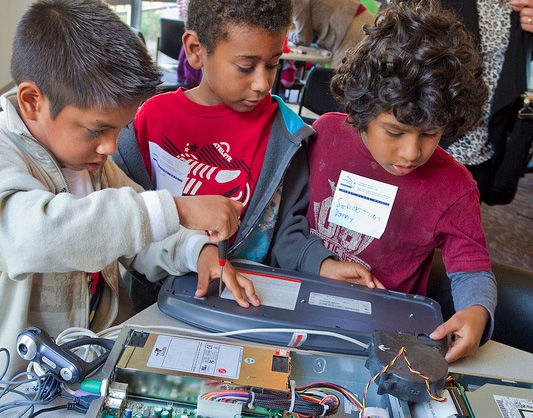28 February 2011
Don’t go it alone: Making outreach work

A group of second-graders visit Lawrence Berkeley National Laboratory to learn about how computers enable science research. (Photo courtesy of LBNL)
Guest post by Phoebe Cohen, Education and Outreach Lead & Postdoctoral Fellow, MIT NASA Astrobiology Team.
In my first post, I discussed my reasons for transitioning from a life as a research scientist to a life as a scientist-educator. That move was made possible in part by the increased push for outreach, driven in the geosciences by NASA’s expanded focus on education, and the National Science Foundation’s requirement for broader impacts in all grant proposals.
“Outreach” is a loosely defined term that refers to activities that aim to improve the public’s awareness and understanding of science outside of regular K-16 school environments — think documentaries, museums, afterschool programs, web sites, and science festivals. Outreach is only one component of what NSF defines as “broader impacts,” which also include activities as wide-ranging as creating community data resources, training post docs, and designing K-12 curricula.
Let us for a moment put aside the reasons why scientists should care about broader impacts (a topic worth its own future blog post) and instead focus on the fact that it’s an increasingly important factor in winning hyper-competitive grants. Despite this fact, there is little opportunity for scientists to gain the skills they need to succeed in outreach, because they are too busy learning the skills they need to succeed in their chosen field – be it measuring stratigraphic sections, analyzing streams of atmospheric pollutant data, or microtoming 600 million-year-old fossils. If funding agencies expect grantees to do broader impact programs that are shown to be effective through evaluation (ah, yet another idea for a future post!), there needs to be more training and partnering infrastructure made available. This problem is wonderfully addressed, along with other “broader impacts” issues, in Corie Lok’s Nature News Feature from last May.
And so in the spirit of not just grumbling at the bad news on my laptop screen, I will try, in this and future posts, to address geoscientists’ need for information on both partnering and training in the vast amorphous universe of “outreach.” By doing so, I hope the experiences that have led me to both grind my teeth and whoop with joy can be of use to others.
My first and perhaps most valuable piece of advice is to remember that there are thousands of groups across the country devoted to increasing the scientific knowledge of the ‘general public.’ Find one. Many universities have community outreach groups somewhere on campus (for an exceptional example, see Vanderbilt’s science outreach page). If there’s nothing at your place of work, reach out to local afterschool programs. Offer to help them write new modules, or run a special hands-on event. Work with a local museum to get funding to develop a temporary exhibit or revamp an existing one. Don’t know where the closest museum is? Nature Network is compiling a fascinating map of science museums around the world, so now you have no excuse. Perhaps you are lucky enough to live in a place that runs a Science Café night that you can get involved with. If not, then band together with others and change your luck.
When trying to reach out to K-12 audiences, working with informal educators (as opposed to ‘regular’ school teachers) is often easier because their activities are not constrained by looming standardized tests. A recent paper by museum guru John Falk and free-choice learning expert Lynn Dierking put forth the excellent point that only 5% of our lives are spent in a classroom. Outreach activities can help bring science to the other 95% of people’s lives. For example, my group is involved in a fruitful collaboration with the Kavli Institute for Astrophysics’ Youth Astronomy Apprenticeship program at the Massachusetts Institute of Technology. By partnering with an existing organization, we can make the most of our limited resources (i.e. time and money), while bringing much-appreciated expertise and energy to this amazing group of curious teenagers.
In my next post, I’ll talk more about ways scientists can get training, both formal and informal, that can help turn outreach activities from a bewildering frustration to something (hopefully) more fulfilling for all involved. Fingers crossed.
– Phoebe Cohen lives in “our fair city”, Cambridge MA, where she informally educates, studies tiny fossils, and takes photos of things.


 The Plainspoken Scientist is the science communication blog of AGU’s Sharing Science program. With this blog, we wish to showcase creative and effective science communication via multiple mediums and modes.
The Plainspoken Scientist is the science communication blog of AGU’s Sharing Science program. With this blog, we wish to showcase creative and effective science communication via multiple mediums and modes.
I am delighted by your discussion of how scientists can engage in the afterschool space. Afterschool programs around the country are extremely interested in being partners in the national STEM education efforts and many are already engaged in some extremely innovative programming. In a recent survey of afterschool program providers, a majority ranked partnerships with content experts as their top need, so I encourage more scientists to get involved. Check out our website to get more information about STEM in afterschool and how you can get involved.
Hi Anita! So glad that you enjoyed the post – I think afterschool programs are an under-utilized resource for scientists seeking to partner with others to do meaningful outreach, and I hope this post pushes a few folks to check out the Afterschool Science directory and make some connections.
Glad to read your post and inspired as well! Lemme check out what/how I can possibly do in avenues if any, in my ‘space’ and community. Thank you.